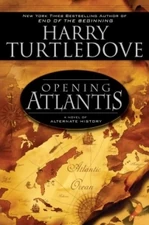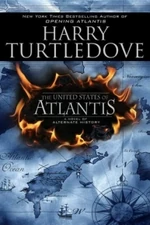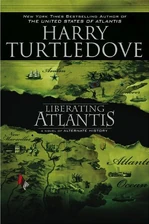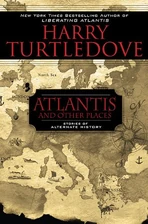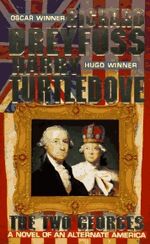Native American is a term used to denote the Amerindian peoples that populated North and South America before its "discovery" by Europeans. European contact generally resulted in profound suffering for these peoples.
European colonization began a process of outright land theft and disenfranchisement of the native peoples that continued into American history. Tribes such as the Cherokee and the Creek were forced off their ancestral lands in Georgia under President Andrew Jackson and forcibly relocated to Indian Territory.
Native Americans in Atlantis[]
Basque fishermen first began the enslavement of the copperskin natives of Terranova in the 1460s. By the 18th century, French and Spanish Atlantis based its economy on the enslavement of copperskins and Negroes. Furious and enslaved copperskins actively plotted rebellion with African fellow-bondsmen.
Spain built its empire on the backs of the gold-rich natives of southern Terranova. The Spanish also treated their copperskin and black slaves badly in its Atlantean colony, causing major hatreds and many rebellions. The Europeans usually manipulated any rivalry between copperskins and blacks to defeat any uprisings.
During the Atlantean War of Independence, Britain hired copperskin mercenaries to invade Avalon. General Victor Radcliff responded by sending 100 men to help support the Avalon militia. After the war, many Terranovan slavery increased, especially in the former English Atlantis.
During the Atlantean Servile Insurrection in 1852, the revolt of the slaves, the copperskins and the blacks cooperated to free themselves. In fact, Frederick Radcliff, leader of the uprising, had a copperskin second-in-command.
Native Americans in Crosstime Traffic[]
Crosstime Traffic was aware of an alternate in which European civilization developed far later than in the home timeline. Consequently, Native American cultures were the most advanced. Footage taken in this alternate was shown to Jeremy Solters and his fellow students in US history class. In another, Europeans had never discovered North America and Native Americans still had a Bronze Age level of technology in the late 21st century.
Native Americans in In High Places[]
After the Great Black Deaths wiped out 80% of the population of 14th century Europe, the continent across the Atlantic Ocean, and its copperskined natives, were not contacted by the Muslim world until the late 21st century.
Native Americans in "The Pugnacious Peacemaker"[]
Skrellings was the name by which Native Americans were known in the alternate timeline where Allister Park found himself.
Native Americans in Southern Victory[]
Native Americans fortunes changed dramatically after the War of Secession:
The Indian Territory was admitted to the Confederacy as the state of Sequoyah. The inhabitants of Sequoyah became a powerful force in CS politics. This was due to fact that they were situated in a location full of resources. The tribes were organized into the Five Civilized Tribes.
In the United States, native peoples suffered the brunt of American frustration and humiliation, as uprisings were crushed without mercy and the Amerindians were forced onto reservations. In the period between the War of Secession and the Second Mexican War, both countries used the Indians within their borders to launch raids into each other's countries. A group of Apaches under the leadership of Geronimo aligned themselves with the CS during the course of the Second Mexican War. However, the long standing tensions between the Apache and the former Mexicans newly admitted to the CS boiled over. The Apache and the CS soon became bitter enemies.
After the Great War, the victorious United States occupied Sequoyah, but refused to admit it as a state. White settlement was encouraged, drowning out the voices of the Native Americans that wished to return to the Confederacy. Sequoyah was not returned to CS during 1941 plebiscite called for by Richmond Agreement as the white settlers, who swiftly became the majority of the population, voted to stay in the US.
During the Second Great War, the frontlines in Sequoyah went back and forth with each side destroying oil wells when it got control of it.
Native Americans in The Two Georges[]
Certain Red Indian groups had sided with Britain during the Seven Years' War. As a reward, the British government did its best to limit the growth of white settlers in North America beyond the existing colonies. Ultimately, this was a failed policy; the white population could not be contained.
Nonetheless, various political leaders of the North American Union, most notably Governor-General George Washington, were able to postpone white appropriation of Indian territories long enough to make a difference. This enabled several groups of Natives to absorb British technologies and practises into their own societies and form Provinces where they dominated; their legal status was comparable to that of the Princely States in British India, where Native rulers continued to exercise power as long as they accepted the fact of British domination. Two Indian groups got Provinces of the NAU devoted to them: the Iroquois in the Province of The Six Nations and the Cherokee in the Province of Cherokee Nation.
In the 1990s, the Sons of Liberty called for North America to be occupied by only the pure and "original" settlers. An inconsistency in their demands was that they also wished the land to be rid of the Native Americans who predated the white settlers.
Native Americans in War World[]
America's Indian tribes suffered toward the end of the CoDominium era, when the ruthlessly efficient Bureau of Relocation would carry out sweeps of slums and of inconvenient minority groups to fill transport ships.
See also[]
- The Blonds of Detina, a group in The War Between the Provinces who were displaced from their own land by advanced colonists from beyond the ocean, much as the Native Americans were displaced by Europeans.
| ||||||||||||||||||||||||||||
| ||||||||||||||||
| ||||||||
| |||||||||||||||||||||||||
| ||||||||||||||
